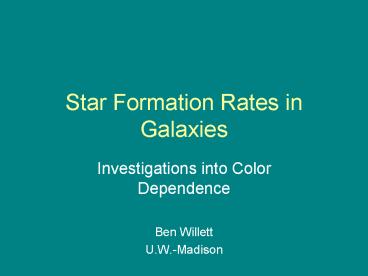Star Formation Rates in Galaxies - PowerPoint PPT Presentation
1 / 13
Title:
Star Formation Rates in Galaxies
Description:
Determine any relationships between the amount of star formation and the color of the galaxy. ... HII regions fluoresce in the H . HII Regions & Star Formation ... – PowerPoint PPT presentation
Number of Views:87
Avg rating:3.0/5.0
Title: Star Formation Rates in Galaxies
1
Star Formation Rates in Galaxies
- Investigations into Color Dependence
- Ben Willett
- U.W.-Madison
2
Project Goals
- Find the star forming regions in the galaxies
from our sample via location of HII regions. - From these HII regions, gauge the amount of star
formation. - Determine any relationships between the amount of
star formation and the color of the galaxy.
3
Preliminaries
- The Interstellar Medium
- HII Regions
4
The ISM
- Composed mostly of gas and dust with 100 times
more gas than dust. lt?gt 1atom/cm3 - Most of the gas composed of HI.
- HI is not uniformly distributed.
- Self gravitation and shocks can cause density
gradients.
5
HII Regions
- HII is ionized hydrogen.
- HII can recombine to a high energy level and then
decay to the ground state emitting photons at ?
656.3nm. - O stars emit light with E gt 13.6ev. HI
surrounding the O star is ionized. - HII Regions occur when the number of ionizations
number of recombinations. - HII regions fluoresce in the H?.
6
HII Regions Star Formation
- How are recently formed stars located?
- ?(O star m.s.) lt 108 yr. ?collapse 106 yr.
- O stars must have formed from the gas indicated
by the HII region. - Initial mass functions predict a certain number
of each kind of star. - HII regions indicate star formation.
7
Procedure
- CCD images taken at CTIO and WIYN.
- IRAF
- On - Off images. H? images are subtracted from
R-band images to eliminate continuum sources.
8
UGCA 270 R-band
9
UGCA 270 H?
10
UGCA 270 On-Off
11
Star Formation Rates
- SFR ? (ltMOBgt NOB / ?OB ) (IMF correction)
- Due to less than perfect observing conditions,
LOB is not known, consequently NOB is not known
and exact SFRs cannot be measured. - Qualitative approach. Provides a measure of the
instantaneous SFR.
12
SFRs and the Colors of Galaxies
- (B - V) color gives an indication of the number
of youthful stars and thus a measure of the
average SFR over a period of 1-5Gyr. - S (ltSFRogt/ltSFR(B-V)gt) provides a measure of the
deviation from the mean at a given time.
13
Implications
- S 1 suggests that SFRs over time are
deterministic. - S lt 1 or S gt 1 suggests that SFRs over time are
chaotic.































